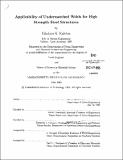| dc.contributor.advisor | Koichi Masubuchi. | en_US |
| dc.contributor.author | Kafetsis, Nikolas K | en_US |
| dc.contributor.other | Massachusetts Institute of Technology. Dept. of Materials Science and Engineering. | en_US |
| dc.date.accessioned | 2007-06-28T12:42:07Z | |
| dc.date.available | 2007-06-28T12:42:07Z | |
| dc.date.copyright | 1995 | en_US |
| dc.date.issued | 1995 | en_US |
| dc.identifier.uri | http://hdl.handle.net/1721.1/37813 | |
| dc.description | Thesis (Nav.E.)--Massachusetts Institute of Technology, Dept. of Ocean Engineering; and, (S.M.)--Massachusetts Institute of Technology, Dept. of Materials Science and Engineering, 1995. | en_US |
| dc.description | Includes bibliographical references (leaves 182-184). | en_US |
| dc.description.abstract | This study presents experimental and numerical results for the strength of welded joints, made on high strength steels with different degrees of strength matching. The steels involved are the HY-100 and HY-130 U.S. Navy, quenched and tempered steels. The test methods are the self restraint cracking test, the tensile test and the fatigue test. The investigated parameters are the strength of the weld metal and the preheat temperature. The self restraint cracking test does not show clearly the expected results, that the required preheat temperature to avoid cold cracking can be reduced by applying undermatched welds at the root of the welding. This conclusion was reached in a similar experiment that was performed on HT-80 high strength steel. The tensile test and the numerical analysis show that the strength properties of the undermatched weld are not the typical properties of the unrestrained weld material. They are greatly elevated due to the restraint effect provided by both the base metal and the stronger surrounding weld metal. Results from the fatigue test show that the degree of strength undermatching, does not affect significantly the crack propagation rate at the joint. | en_US |
| dc.description.statementofresponsibility | by Nikolas K. Kafetsis. | en_US |
| dc.format.extent | 184 leaves | en_US |
| dc.language.iso | eng | en_US |
| dc.publisher | Massachusetts Institute of Technology | en_US |
| dc.rights | M.I.T. theses are protected by copyright. They may be viewed from this source for any purpose, but reproduction or distribution in any format is prohibited without written permission. See provided URL for inquiries about permission. | en_US |
| dc.rights.uri | http://dspace.mit.edu/handle/1721.1/7582 | |
| dc.subject | Ocean Engineering. | en_US |
| dc.subject | Materials Science and Engineering. | en_US |
| dc.title | Applicability of undermatched welds for high strentgh steel structures | en_US |
| dc.type | Thesis | en_US |
| dc.description.degree | S.M. | en_US |
| dc.description.degree | Nav.E. | en_US |
| dc.contributor.department | Massachusetts Institute of Technology. Department of Materials Science and Engineering | |
| dc.contributor.department | Massachusetts Institute of Technology. Department of Ocean Engineering | |
| dc.identifier.oclc | 43895486 | en_US |
